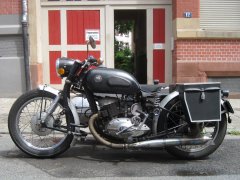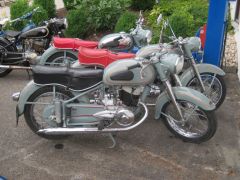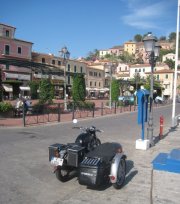A Victoria KR26 rig (motorbike with sidecar)
Victoria was a renown bicycle and motorbike manufacturer from Nuremberg. The company was founded back in 1886 as
"Frankenburger und Ottenstein Nürnberg". Motorcycle production started in 1920 with boxer engines (cylinders
aligned in drive direction). The series of popular two strokers started in 1937 with two 200 cc and one
250 cc model, the KR 25 S. Victoria bikes then had almost 8% of market share in Germany.
The so called "New Line", with a good and clean design and block engines, was continued after World War II
and developed further until 1954, when the German motorcycle market dropped. The last model was the KR 26 (N). These were
(and are) high quality motorbikes and very reliable, but had the flaws of too much weight (151 kgs) and not
enough power (max. 14 HP). About 12,000 of these motorbikes were produced and sold until 1955.
Official Victoria drivers won lots of prizes and competitions.
The author founded the "Victoria Association" back in 1988 (it is still successful) and built a first rig based on this
two stroker in 1988/1989. A highly improved and customized sidecar Victoria followed in 2014. Several personal tours from Frankfurt, Germany,
to Italy (mostly the Elba and Sardinia islands) have proven that these vintage motorbikes are still competitive
(symbol: wink).
Sections of this page:
Scope of the Website
Sorry, the pages of this site are available in German only. Please don't hesitate to contact us for
clarifications; a lot of people from all over the world do so.
If you are a vintage motorbike fan or driver, you likely encountered challenges during your research of know-how and how-to information.
The main scope of this website is to provide information and technical assistance for these models. It took several years
to collect as much material as possible that is now available to the public via the web. Please remember that at the time
the association was founded the internet was not born yet (and neither e-mail). Nowadays it's the #1 medium.
While I criticized the lack of power above, this is not really precise. Please remember that these motorbikes were mass manufactured,
and as such were subject to some fast production flaws. The truth is that the engines are good for about 17 HP without
"real" tuning (that is, only via some minor improvements, minor at least for grease monkeys with at least medium experience
(symbol: laugh) ).
These improvements (plus customizing) are a further topic of this website. Another topic is saving weight. In fact, our
motorbike weights only about 130 kg and the whole rig less than 195 kg. The first combined with about
17 HP makes 7.6 instead of 10.8 kg/HP, the whole rig (213 vs.
195 kg) 11.5 instead of 15.2. It is good for about 62 mph with a passenger in
the aluminum "boat".
Philosophy
Anybody can buy a modern motorcycle and cruise fast. And yes, there are a lot of good ones available. However, at least for
my daughter and me, it is more satisfying to continue the development of an excellent vintage motorbike beyond where it stopped due to
commercial constraints. This is in some way a horror to purists and people who over restore old bikes until they look
like new or better—of course, in original state—only to chime in at mid-summer meetings or to look at them in the garage.
In reality, anyone who drives such a vehicle daily (if they can) must and should adopt to modern traffic, which means better lights,
excellent brakes, daylight running lights, an efficient horn and so on. Moreover, it is a design challenge to make improvements that look
like they have their origins back in the 1950s. Custom motorbikes are much less common and popular in Germany than they are in the
UK or U.S. - and at times this provokes lively discussions,
especially at conventions and in forums.
Anyway, we don't waste rare and good parts that might help others to complete their "original bike", but prefer scratch-building
or restoring parts that are in bad condition. Function is more important than some rust.
Last, but not least, relaxed tours and road trips at a pace less than 40 mph
with no pressure to hurry are a very special experience. You'll see (and smell) the landscape on smaller roads, get in touch lots
of people, have enough time for a good meal or photo opportunity and return home relaxed.


